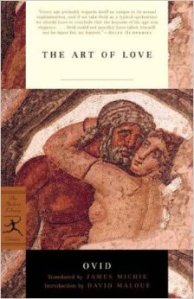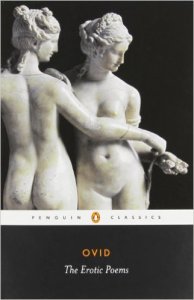If anyone in Rome does not know the art of loving,
let him read this poem and let him love.
—Ovid’s “The Art of Love”
 It could be said that Ovid taught me Latin.
It could be said that Ovid taught me Latin.
It didn’t seem that way at the time.
Ovid? I loved Ovid. I read his epic poem, Metamorphoses, a collection of retellings of Greek and Roman myths, when I was eight, because it was in the “mythology” section of the library. Years later, I wrote an “effervescent” paper on Metamorphoses (i.e., not scholarly: I was the master of bubbly pop prose) and was urged to take Latin.
Latin? Who had time? I was busy. I had no time. And overnight life had changed when I signed up for Greek. Before that, I had long lunches every day at the Union, coffee at Grace and Rubies (a women’s club immortalized in a story by T. C. Boyle), and at night went to movies. To acquire leisure, I signed up every semester for at least one class where I had already done the reading: the Brontes, Dickens, Emily Dickinson, Eliot, Hawthorne, Melville, Hardy, Lawrence.
But now there was Greek. I could no longer get by on witty little essays about gender issues. No, I had to know things! I memorized paradigms, learned the strange rules of grammar and syntax, and translated adapted Xeonophon. Then we read tiny amounts of Lysias, parsing every sentence and identifying rhetorical figures of speech. Why did I love it? Who knows?
 Finally I agreed to take Latin. I do not know what happened to my brain then. The Latin fell into place like tiles on a Scrabble board. Honestly, it had to be reincarnation: I was a Roman matron in another life. I scanned poetry at sight, while everybody else laboriously divided lines into syllables and marked the feet…
Finally I agreed to take Latin. I do not know what happened to my brain then. The Latin fell into place like tiles on a Scrabble board. Honestly, it had to be reincarnation: I was a Roman matron in another life. I scanned poetry at sight, while everybody else laboriously divided lines into syllables and marked the feet…
I fell in love with witty, charming Ovid during a summer poetry class. Breezy Ovid for breezy summer. His Latin is indescribably elegant: lines of poetry are braided with figures of speech and interlocking word order. Take Ovid’s version of the myth of Daedalus and Icarus. When Daedalus makes wings for himself and his son to escape from Crete, he puts the finishing touches on the work and then,
“the artisan balanced on twin wings…”
But in the Latin, the word “artisan” is placed between the adjective “twin” and the noun “wings,”making it literally seem that Daedalus is balanced on wings.
…geminas opifex libravit in alas
… [on] twin the artisan balanced on wings
We can’t do this in English, because word order determines meaning.
In addition to Metamorphoses, I have enjoyed Ovid’s witty love elegies (Amores) and The Art of Love (Ars Amatoria). These poems are mostly comical, but occasionally touch on serious issues: in Amores, there are two poems about his mistress’s abortion.
I am now rereading The Art of Love ( Ars Amatoria), a satiric didactic poem on how to pick up women (and the last section is for women on how to pick up men). May I just say this is my least favorite of his poems? There was a tradition of Roman didactic poems, Lucretius on Epicureanism, Virgil on farming, but Ovid’s is silly, lusty, satiric, and outrageous. It goes too far sometimes.
Love is a frivolous entertainment in Ovid’s world. He acknowledges the goal is to find a woman you love, but is not adverse to a one-night stand.
How do you meet women, if you haven’t read his book of love? He has many suggestions: parties, porticos, the Palatine, the races. The best place? The theater.
But especially hunt in the theater’s curve,
this place is more fertile than your wildest desire.
There you will find someone to love, or someone you can play with,
someone to touch, or someone you wish to hold.
And sometimes he goes far, too far, really too far, in his mythological parallels about love . In fact, there is a whole section on grotesque myths about women’s loves, starting with Pasiphaë, Minos’ wife, who falls in love with a bull and gives birth to the minotaur. (What IS the origin of that myth?)
And, by the way, Pasiphase and Minos are connected to Daedalus, who built the labyrinth for the Minotaur, and then angered Minos by giving the clue to help Theseus escape.
The exasperated editor of my Latin commentary writes copious notes on Pasiphaë but then abruptly pauses to explain,
327ff. More stories of disgusting and unnatural female lust.
And, yes, they are disgusting, but I have never seen a note like that/
Ovid’s version of the Pasiphaë myth is often hilarious. He asks why she brings a mirror on the mountains among the cows and why she keeps foolishly combing her hair: “Trust the mirror, which says you are not a heifer.”
Pasiphaë wonders why the bull thinks the heifers dancing in the grass are pretty. And she eliminates some of his mistresses by sending them to plow, or sacrificing them for some made-up religious ritual.. She is very violent during the sacrifices.
At one point Ovid flippantly comments,
Whether or not Minos pleases, no adulterer should be sought;
but if you prefer to deceive a man, deceive with a man.
I agree!
Finally, she deceives the bull with a wooden cow and is impregnated with the minotaur. He does not give details, thank God. There was a similar rumor about Catherine the Great and a horse. What is the origin of these stories? Well, hm, one day, maybe next year, or the year after, I’ll go to a library in a distant city and look it up!
Poor Ovid. He was not living in good times–are any of us living in good times?–and it was not apparently a good time to write racy poems about love. Augustus banished Ovid to an island for carmen et error, a poem and an error, or at least that’s what Ovid wrote.. Scholars speculate that the poem was Ars Amatoria. But speculation means so much to scholars…and so little to the rest.

Why is female lust disgusting and unnatural? Would a commentator say that about male lust? I’m intrigued…
LikeLike
Well, it was a she…I think she was fed up with the grotesque myths about women. But I must admit his men are often grotesque, too.
LikeLiked by 1 person
An amusing note from the commentary on Ovid, but not the only one of its type. Those Victorians… One of my favorites is from Merrill’s Catullus on Poem 32:
“Contents: execrable. Date, undeterminable. Metre, Phalaecean”
Just thought you might be amused.
I’ve been reading your blog and enjoying it for a while. Thanks!
LikeLike
Yes, those Victorians can be prudish. I have the Merrill edition, too. My Ars Amatoria was fairly recent, so I was surpirsed.
LikeLike
Didnt Daedalus design and fabricate the wooden heifer as well? seem to remember that from somewhere. I also wonder where the themes of female human and male animal originated. More male human anxieties perhaps.
LikeLike
Yes, he did! There may have been a bull cult on Minoan Crete, but little is known about it. I’m sure someone has written on this theme.
LikeLike